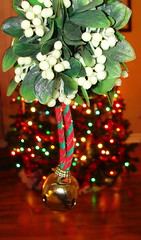
Perhaps some of you have already experienced a sweet holiday smooch or two under the Christmas mistletoe, enjoying this fairly old kissing ritual for people. But mistletoe is important in other vital ways: it provides essential food, cover, and nesting sites for an amazing number of critters in the United States and elsewhere. In fact, says Rob Bennetts, a USGS research scientist, some animals couldn’t even survive without mistletoe, including some birds, butterflies, and insects. But first, a little bit about the plant. The white-berried Christmas mistletoe we hang so hopefully in places where our sweethearts will find us lingering, is just one of more than 1,300 species of mistletoe worldwide. Globally, more than 20 mistletoe species are endangered. Two kinds of mistletoes are native to the United States: the American mistletoe (the one commonly associated with our kissing customs) and the dwarf mistletoe. American mistletoe is found from New Jersey to Florida and west through Texas. The dwarf mistletoe, much smaller than its kissing cousin, is found from central Canada and southeastern Alaska to Honduras and Hispaniola, but most species are found in western United States and Mexico. Mistletoe is no newcomer to this country: excavations of packrat middens reveal that dwarf mistletoes have been part of our forests for more than 20,000 years. Some fossil pollen grains even indicate that the plant has been here for millions of years. Says Bennetts: "Mistletoes should be viewed as a natural component of healthy forest ecosystems, of which they have been a part for thousands, if not millions of years."
No comments:
Post a Comment